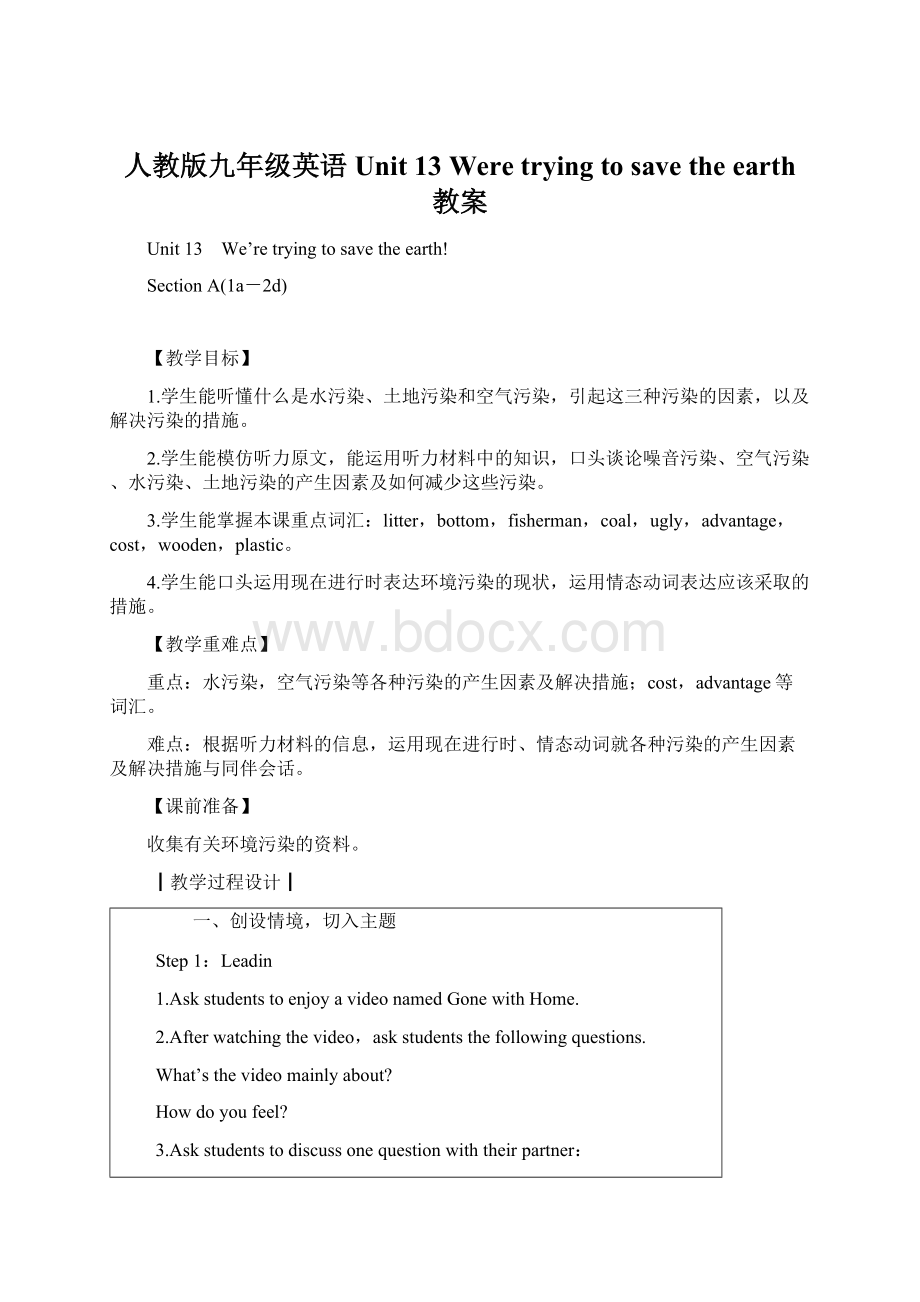人教版九年级英语Unit 13 Were trying to save the earth 教案Word格式.docx
《人教版九年级英语Unit 13 Were trying to save the earth 教案Word格式.docx》由会员分享,可在线阅读,更多相关《人教版九年级英语Unit 13 Were trying to save the earth 教案Word格式.docx(21页珍藏版)》请在冰豆网上搜索。

难点:
根据听力材料的信息,运用现在进行时、情态动词就各种污染的产生因素及解决措施与同伴会话。
【课前准备】
收集有关环境污染的资料。
┃教学过程设计┃
一、创设情境,切入主题
Step1:
Lead�in
1.AskstudentstoenjoyavideonamedGonewithHome.
2.Afterwatchingthevideo,askstudentsthefollowingquestions.
What’sthevideomainlyabout?
Howdoyoufeel?
3.Askstudentstodiscussonequestionwiththeirpartner:
Inourdailylife,whatkindofpollutioncanyouthinkof?
设计意图:
通过视频《留住美丽地球》,震撼学生的心心灵,帮助学生了解环境污染及生态破坏的种种现象,并使他们意识到环境保护的危机感与紧迫感。
同时,联系身边生活,结合本城市环境状况,引导学生进一步熟悉话题。
二、展开过程,探究新知
Step2:
Presentation
1.Askstudentstolookatthepicturesin1aandtalkaboutit.
2.Theteachercanaskstudentsthefollowingquestion:
Whatelsecancauseeachkindofpollution?
Thenaskstudentstodotheexercisein1a.
让学生对于环境污染的类型有一个初步的了解,熟悉话题,为下面的听力活动做好内容和词汇上的准备。
Step3:
Listeningto1b
Beforelistening
Askstudentstopredictwhatkindofpollutiontheywilllistentoin1b.
从内容和语法上对听力进行预测。
Whilelistening
1.Playtherecordingtwiceforstudentstocompletethechart.
2.Askastudenttoreadhisorheranswers.
3.Letstudentschecktheiranswersthattheyhavepredicted.
听这两遍时,更加注重细节。
Afterlistening
1.Readafterthetaperecorderandpayattentiontothepronunciationandintonation.
2.Askstudentstopracticetheconversationwiththeirpartner.Then,askstudentstoactouttheconversation.
3.Askstudentstomaketheirownconversationandactouttheconversation.
听后,再次整体回扣文本,并进行语音语调的学习。
然后,通过pairwork让学生内化听取的信息语言。
Step4:
Listeningto2a
Askstudentstoguesstheanswers.
提高学生的兴趣,并促使他们在听的过程中有目标地集中注意力。
Playtherecordingforstudentstocirclethekindsofpollutiontheyhear.
Checktheanswers.
Step5:
Listeningto2b
有推断的预测可以帮助学生在听录音时更有效地捕捉关键词汇。
1.Playtherecordingforthefirsttimeanddotheexercisein2b.
2.Playtherecordingagainandletstudentscorrecttheiranswers.
1.Letstudentsreadtheconversationin2cafterthetaperecorder.
2.Role�playtheconversation.
让学生模仿录音中的语音语调,提高口语表达能力。
Step6:
Role�play
1.Read2dandcompletethechart.
Problems
Solutions
airpollution
wastepollution
wooden(木头的)chopsticksorplasticforks
rubbish
增加表格可以帮助学生梳理和识记信息,为role�play做好准备。
2.Letstudentsreadtheconversationafterthetaperecorder.
3.Askstudentstopracticetheconversationwiththeirpartner.Duringtheconversation,theyshouldhaveeyecontact.
让学生看着同伴的眼睛,是为了让他们体会到与人交流的真实性,而不是各读各的语句。
Step7:
Languagepoints
Theteacherexplainsthenewwordsandexpressionstostudents.Andaskstudentstotakenotes.
三、布置作业
口头作业
Listento1band2b.Thenrecitethem.
书面作业
1.Trytomemorizethenewwordsandlanguagepoints.
2.Theearthisbadlypolluted.Pleasethinkofwhatwecandotosavetheearthandmakeapostertotellmorepeopletosavetheearth.
┃教学小结┃
【板书设计】
SectionA(1a-2d)
Formsofpollution
Causes
Airpollution
factories,cars,burning
Waterpollution
factories,rubbish,ships
Landpollution
rubbish,batteries
Noisepollution
loudmusic,crowds,cars
SectionA(3a-4c)
1.学生能掌握词汇:
重点词汇(cruel,harmful,industry,law,scientific,afford);
认读词汇(shark,fin,chain,ecosystem,reusable,transportation);
表达方式(beharmfulto,atthetopof,thefoodchain,takepartin,turnoff,payfor,takeaction).
2.引导学生谈论珍稀动物濒危的原因及拯救措施。
3.帮助学生复习语法项目,包括现在进行时、usedto、被动语态、现在完成时、情态动词等。
1.本课时的重点词汇,表达方式及语法项目。
2.学习鲨鱼濒危的原因及拯救措施。
3.学生就珍稀动物的濒危原因及拯救措施进行写作。
1.学生正确使用连词。
2.结合实际生活就珍稀动物的濒危原因及拯救措施进行写作。
1.搜集有关鲨鱼的资料。
2.制作多媒体课件和学案。
3.准备其他有关珍稀动物的现状及拯救措施。
Step1:
1.Theteachercanhaveafreetalkwithstudentsaboutanimals,especiallyendangeredanimals.
教师与学生自由交谈,导入动物保护的话题。
Pre�reading
1.Showstudentsavideoandhaveadiscussion.
2.Afterwatchingthevideo,theteachercanaskthequestionsbelow.
Canyousaysomethingaboutsharks?
Doyouthinktheyareendangered?
Whyaretheyendangered?
通过这一环节,教师在了解学情的同时,可以帮助学生全面的了解鲨鱼,对接下来的阅读也会有更好的帮助。
While�reading
FastReading
Theteachercanaskaquestionlikethis:
Doyouwanttoknowmoreaboutsharks?
PleaseturntoPage99.
Lookthroughthearticlequicklyandanswerthequestion:
Whereisthisarticleprobablyfrom?
A.Abook. B.Anovel. C.Anewspaper.
帮助学生理解文章的体裁以及作者的写作意图。
CarefulReading
1.LetstudentsreadParagraph1andwriteTfortrueandFforfalse.
(1)Shark’sfin(鱼鳍)soupi